Anita Mitra Revives Kantha: Blending Tradition with Contemporary Art - GetBengal Story
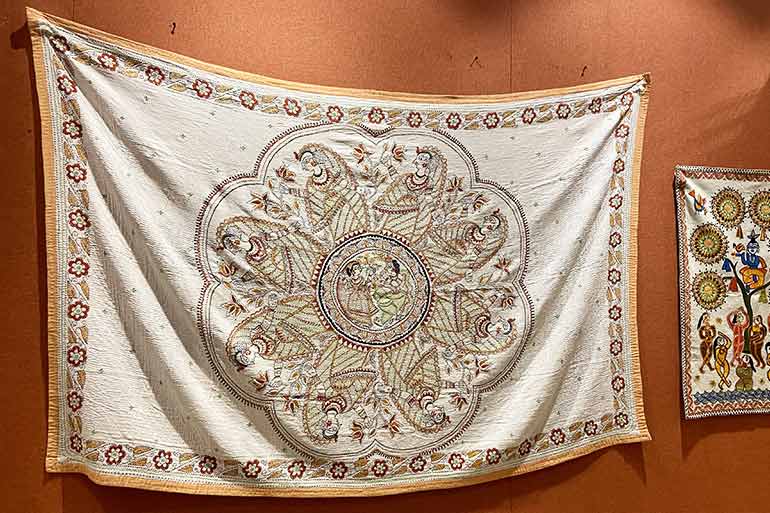
“In the 1980s, Kolkata’s fashion scene saw a wave of inspiration from Shantiniketan’s batik alpana. This led to the creation of ‘Ranstitchl’—a style where women’s sarees and outfits were crafted with intricate stitching on a single piece of cloth. ‘Kantha stitch’ sarees became popular, promoted by a group of Shantiniketan alumni who had started their business," said artist Anita Mitra.
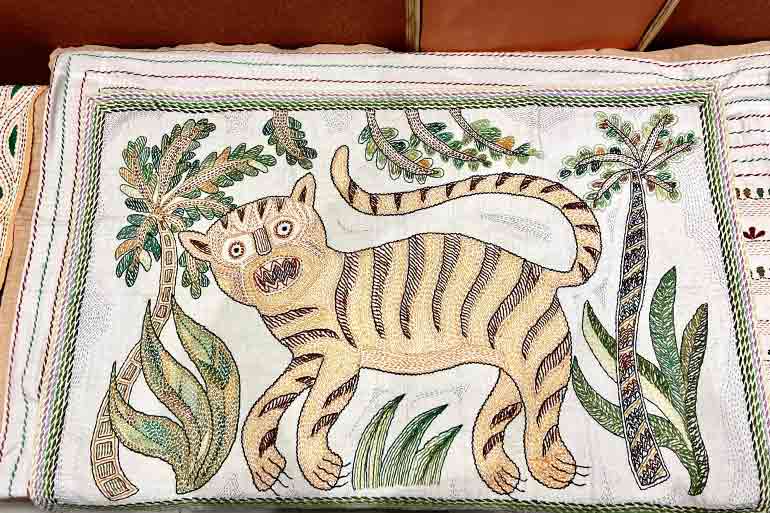
Kantha embroidery is not just about sarees, kurtas, or Shantiniketan. It has its own rich tradition and artistic depth. In the 14th century, Chinese paintings depicted such intricate stitching techniques that they looked like painted images. During an exhibition in March at the Women's Christian College, I was struck by the same feeling while observing Anita Mitra's unique Kantha art. Each stitch, each layer of colour, reflected a significant mastery. Her work beautifully merges traditional and contemporary themes.
Over the past 30-40 years, her pieces have been the result of extensive research and dedication. Though she trained in Western-style fine arts at Kolkata’s Government Art College, Kantha embroidery became her personal space of expression. Over time, it transformed into the medium for her artistic vision.
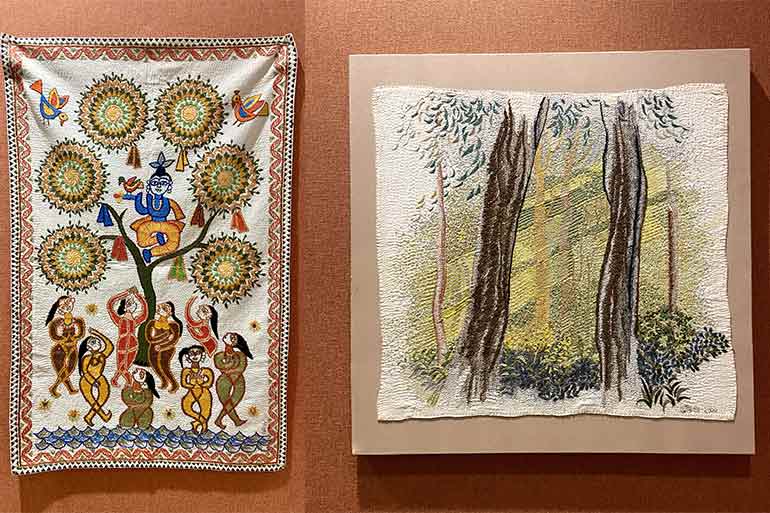
"I watched my mother making Kantha, so there was never any doubt about the importance of layering in Kantha work. At the Shantiniketan school, we were taught embroidery by Khomadi, or Khoma Ghosh. It was there that the flow and texture of the thread left a deep impression on my mind. But I don’t remember seeing anyone doing Kantha work in Shantiniketan during the 1950s and 60s! There was plenty of interest in batik, leather batik, tie-dye, and some traditional embroidery on fabric. Yet, I never saw any designs on the Kantha my mother made! Much later, I started designing them myself. Before I began my research, I used to call it 'Shantiniketani Design.' Sculptor Mira Mukherjee also encouraged me a great deal," says Anita.
According to her, most people, especially the so-called educated, affluent class, consider Kantha to be a lowly, poor man’s winter blanket. They fail to understand whether Kantha is 'art' or 'craft'.
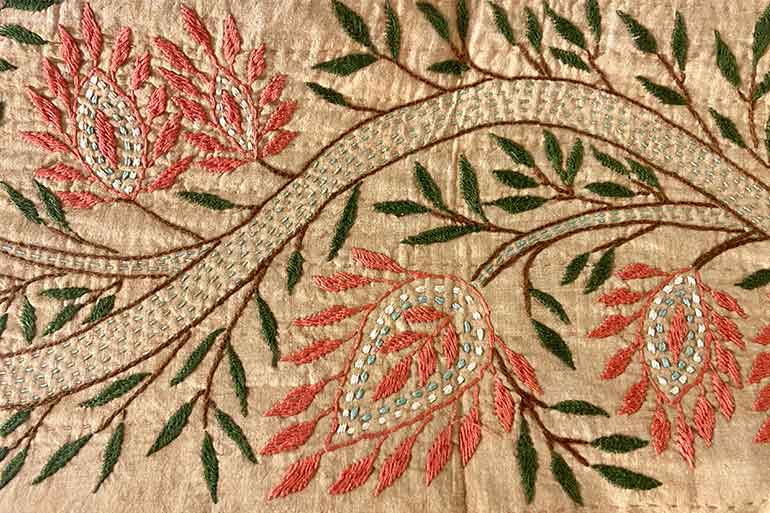
As Anita Mitra puts it, "Since the movement of a brush matches the pace of thought, painting is dynamic and thus 'art.' On the other hand, Kantha work, which is done slowly with the needle, doesn’t match the rhythm of thought. The rural nature of their designs lacks the influence of formal art education. Girls just sew Kantha as a habit, so it’s 'craft.' This is a strange argument! This explanation shows narrow-mindedness. One major reason for the decline of Kantha art is that the market is flooded with consumer goods. As a result, urban people quickly forgot Kantha. The current generation doesn’t even know what 'Kantha' is. To make matters worse, fraudsters have taken advantage of people's ignorance, selling sarees under the name of Kantha stitch."
Kantha is truly a woman’s art. To be more precise, it’s a household women’s art. In the past, elderly women of the house never wasted their free time. Old fabric scraps became their canvas, colourful threads moved like brush strokes, and they became the artists. Not all their work was meant to be framed or preserved, but Kantha became a spontaneous medium for expressing their unique creativity, thoughts, and experiences. Unfortunately, we are still far behind in bringing Kantha out of the domestic sphere and establishing it as an ‘art.’ The state of the textile departments in the art colleges of this country shows this clearly. While many parents are eager to send their children to art colleges to learn painting or sculpture, they look down upon the sewing arts.
Kantha art has indeed become commercial and global, but it cannot be denied that this art has been somewhat belittled by labelling it as ‘craft,’ with the intention of turning it into a product. There is a clear distinction between Kantha art and simple Kantha stitching. Taking advantage of Bengali nostalgia, low-quality Kantha-stitched fabrics are being sold under the name of Kantha art everywhere.
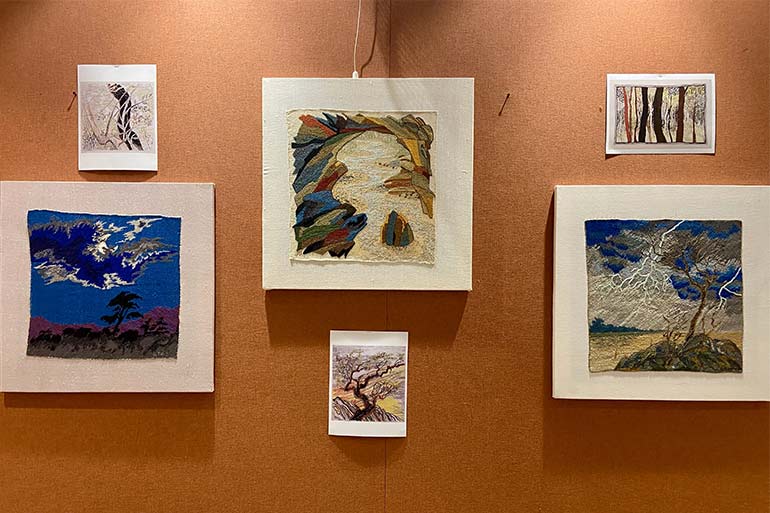
In Kantha art, there were various types of stitches such as Dharuni, Cross, Bharat, Gudi, Ran, Double Ran, Tercha, Kuchi, Gath, Chain, Nisharon, Dal, and Dorokho (a Kantha looks the same on both sides). Since most Kantha work is now done for commercial purposes, the focus is mostly on Ran (which takes the least time), Bhorat, Cross, and Benki stitches. The designs have become conventional, and although there is effort, there is little research or attempt to innovate. In the age of artificial intelligence, artists like Anita Mitra bring us back to our roots, while encouraging the new generation to explore new paths in the art of stitching.
The commercialisation of Kantha in Bengal is not a new phenomenon. In the past, the embroidery craft of various regions in India was deeply influenced by the local culture. For example, the ancient commercial capital of Bengal, Saptagram or Satgaon, was renowned for its fine Kantha embroidery. The designs on these Kanthas depicted a blend of Indian and European art, featuring deities, nature, animals, and people. These Satgaon Kanthas were a testament to the fusion of two distinct cultures, thoughts, and creativity. They were first discovered in the late 16th century in the Hooghly district, and after the fall of Portuguese rule, the East India Company also exported these Kanthas.

Recently, the excellent examples of this traditional art form were showcased at the "Textiles from Bengal: A Shared Legacy" exhibition at the KCC in Kolkata, organised by the Weavers Studio Resource Centre. Additionally, recent events such as the much-discussed Kantha installation at the Bengal Biennale, the state's annual Nakhshi Kantha exhibition, and the Padma Shri award given to Bengal’s Takdira Begum and Preetikona Goswami for their contributions to Kantha are undoubtedly commendable initiatives.










